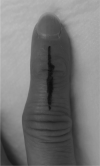Causes of Procedural Failures of Closed Reductions using an Extension-Block Pin for Bony Mallet Finger
- PMID: 33867764
- PMCID: PMC8041496
- DOI: 10.1055/s-0040-1701318
Causes of Procedural Failures of Closed Reductions using an Extension-Block Pin for Bony Mallet Finger
Abstract
This retrospective study evaluated procedural failures of closed reductions using an extension-block Kirschner wire (K-wire) for bony mallet finger. A total of 132 patients who underwent a closed reduction for bony mallet finger in a procedure using an extension-block K-wire were radiographically assessed. Radiographs were used to evaluate (1) postoperative displacement of the reduction before or after K-wire removal and (2) inaccurate reduction of the fragment immediately after surgery. The causes of procedural failure and bone union were evaluated using radiographs and medical records of the intraoperative findings. Out of 132 patients, 17 with procedural failure were enrolled. Displacement of the reduction before and after K-wire removal occurred in seven and six cases, respectively. Inaccurate reduction immediately after surgery occurred in four cases. The most common cause of procedural failure was inaccurate insertion of the K-wire to fix the distal interphalangeal joint (eight cases) followed by inaccurate insertion of the extension-block pin (five cases). All patients had bone union regardless of the displacement of the reduction or inaccurate reduction of the fragment. Caution should be exercised during the reduction and fixation when an extension-block K-wire is used in a closed reduction procedure.
Keywords: bony mallet finger; displacement of the reduction; mallet finger; postoperative displacement; procedural failure.
Society of Indian Hand & Microsurgeons. All rights reserved. Thieme Medical and Scientific Publishers Pvt. Ltd., A-12, 2nd Floor, Sector 2, Noida-201301 UP, India.
Conflict of interest statement
Conflict of Interest None declared.
Figures




Similar articles
-
Correlation between extension-block K-wire insertion angle and postoperative extension loss in mallet finger fracture.Orthop Traumatol Surg Res. 2018 Feb;104(1):127-132. doi: 10.1016/j.otsr.2017.08.018. Epub 2017 Oct 9. Orthop Traumatol Surg Res. 2018. PMID: 29024745
-
Modified extension-block K-wire fixation technique for the treatment of bony mallet finger.Orthopedics. 2010 Oct 11;33(10):728. doi: 10.3928/01477447-20100826-10. Orthopedics. 2010. PMID: 20954665
-
Extension pin block technique versus extension orthosis for acute bony mallet finger; a retrospective comparison.Orthop Traumatol Surg Res. 2021 Sep;107(5):102764. doi: 10.1016/j.otsr.2020.102764. Epub 2020 Dec 24. Orthop Traumatol Surg Res. 2021. PMID: 33333280
-
Surgical treatment of the bony mallet thumb: a case series and literature review.Arch Orthop Trauma Surg. 2022 May;142(5):887-900. doi: 10.1007/s00402-021-04333-w. Epub 2022 Jan 15. Arch Orthop Trauma Surg. 2022. PMID: 35032189 Free PMC article. Review.
-
Review of Acute Traumatic Closed Mallet Finger Injuries in Adults.Arch Plast Surg. 2016 Mar;43(2):134-44. doi: 10.5999/aps.2016.43.2.134. Epub 2016 Mar 18. Arch Plast Surg. 2016. PMID: 27019806 Free PMC article. Review.
Cited by
-
[Treatment of Wehbe-Schneider typesⅠB and ⅡB bony mallet fingers with one-stage closed reduction and elastic compression fixation with double Kirschner wires].Zhongguo Xiu Fu Chong Jian Wai Ke Za Zhi. 2022 Apr 15;36(4):400-404. doi: 10.7507/1002-1892.202112088. Zhongguo Xiu Fu Chong Jian Wai Ke Za Zhi. 2022. PMID: 35426276 Free PMC article. Chinese.
References
-
- Lin J S, Samora J B. Surgical and nonsurgical management of mallet finger: a systematic review. J Hand Surg Am. 2018;43(02):146–163. - PubMed
-
- Ishiguro T, Itoh Y, Yabe Y, Hashizume N. Extension block with Kirschner wire for fracture dislocation of the distal interphalangeal joint. Tech Hand Up Extrem Surg. 1997;1(02):95–102. - PubMed
-
- Hiwatari R, Saito S, Shibayama M. The ‘chased method’ of mini screw fixation: a percutaneous surgical approach to treating mallet fractures. J Hand Surg Eur Vol. 2014;39(07):784–786. - PubMed
-
- Bischoff R, Buechler U, De Roche R, Jupiter J. Clinical results of tension band fixation of avulsion fractures of the hand. J Hand Surg Am. 1994;19(06):1019–1026. - PubMed
-
- King H J, Shin S J, Kang E S. Complications of operative treatment for mallet fractures of the distal phalanx. J Hand Surg [Br] 2001;26(01):28–31. - PubMed
LinkOut - more resources
Full Text Sources

